A revision of the Zygothrica samoaensis species group (Diptera: Drosophilidae), with division into three species subgroups and description of five new species
Abstract
This revision deals with the Zygothrica samoaensis species group, which includes 15 species, five of which are described as new to science. Two synonymies are proposed: Z. vietnamensis Grimaldi, 1990, as a junior synonym of Z. flavofinira Takada, 1976, and Z. britannia Grimaldi, 1990, as a junior synonym of Z. malaysiana Grimaldi, 1990. The samoaensis group is divided into three species subgroups: (i) the samoaensis subgroup, consisting of nine species, including a new species, Z. australiaensis sp. nov.; (ii) the fijiana subgroup of Z. fijiana Takada, 1976, and two new species, Z. triscutellaris sp. nov. and Z. bicornigera sp. nov.; and (iii) the leptorostra subgroup of Z. leptorostra Grimaldi, 1990, and two new species, Z. pimacula sp. nov. and Z. quintamaculata sp. nov. Supplementary information on geographic distribution is provided for some species, as well as a key to all species of the samoaensis group. Zygothrica kokodana Grimaldi, 1990, and Z. paleovitta Grimaldi, 1990, have closer affinity with the hirticornis and the quadrivittata species groups, respectively, and so are moved to the corresponding genus Hirtodrosophila.
INTRODUCTION
The Zygothrica samoaensis species group was erected by Grimaldi (1987) as the clade 2.1 based on a cladistic analysis of the genus Zygothrica Wiedemann. Whereas most Zygothrica species are Neotropical (107 species) and two more species are known from Africa (Grimaldi 1990; Tsacas 1990), the samoaensis group is exclusively distributed in the Indo-Pacific region. Malloch (1934) described the first Zygothrica species outside of the Neotropics, Zygothrica samoaensis from the Samoan Islands. Takada (1976) added two species, Z. fijiana from Fiji and Z. flavofinira from the Malay Peninsula, to the Indo-Pacific fauna of Zygothrica. Takada’s third species, Z. malayana, was transferred to the subgenus Dudaica Strand of the genus Drosophila Fallén by Grimaldi (1990). Most recently, Grimaldi (1990) revised the samoaensis group with description of nine new species, raising the number of known species in this group to 12. The kokodana and the paleovitta species groups, both consisting of single species, were also added to the Indo-Pacific region (Grimaldi 1990).
The present study was based on collections made in recent years, mostly by us, in the Indo-Pacific region. More than 1000 Zygothrica specimens were recovered. Nearly all the specimens were collected on fungi, including a few reared from fruiting bodies. Therefore, mycophagy seems to be the rule in the samoaensis group, a plesiomorphic habit common in Zygothrica and shared with the related genera Hirtodrosophila Duda and Mycodrosophila Oldenberg. Examination of those specimens leads us to recognize and describe five new species and to propose synonymy for two known species, leaving the samoaensis group with 15 species. Moreover, we propose to divide the samoaensis group into three species subgroups. Some new records of geographic distribution are given for known species, and a key to all species of this group is provided. Furthermore, we propose nomenclatural changes with the move of Z. kokodana Grimaldi, 1990, and Z. paleovitta Grimaldi, 1990, to the genus Hirtodrosophila.
MATERIALS AND METHODS
Specimens studied were preserved in 70% ethanol or dried and pinned. External morphology was observed under a stereoscopic dissecting microscope and metric characters were measured with an ocular micrometer. Morphological terminology followed McAlpine (1981) and measurements followed Zhang and Toda (1992), except for four new values indicative of the relative lengths of the prementum (prem/o) and the palpus (palp/o) to the maximum diameter of the eye, and of the relative length (sctl2) and position (sctlp2) of the additional scutellar seta (if present) to the apical scutellar seta (Table 1). The male and female terminalia were detached from the body, cleared by warming in 10% KOH solution at approximately 100°C for several minutes, observed in a droplet of glycerol under a compound light microscope, and illustrated, at the same scale, for most species on the basis of microscope photographs taken by a digital camera. The dried pinned specimens were softened by warming in 70% ethanol for several minutes before dissection.
| BL | Straight distance from anterior edge of pedicel to tip of abdomen |
| ThL | Distance from anterior notal margin to apex of scutellum |
| WL | Distance from humeral cross vein to wing apex |
| WW | Maximum wing width |
| arb | Dorsal branches/ventral branches of arista |
| FW/HW | Frontal width/head width |
| ch/o | Maximum width of gena/maximum diameter of eye |
| prem/o† | Length of prementum/maximum diameter of eye |
| palp/o† | Length of palpus/maximum diameter of eye |
| prorb | Proclinate orbital seta/posterior reclinate orbital seta in length |
| rcorb | Anterior reclinate orbital seta/posterior reclinate orbital seta in length |
| vb | Subvibrissal seta/vibrissa in length |
| dcl | Anterior dorsocentral seta/posterior dorsocentral seta in length |
| presctl | Prescutellar seta/posterior dorsocentral seta in length |
| sctl | Basal scutellar seta/apical scutellar seta in length |
| sctl2† | Additional scutellar seta/apical scutellar seta in length |
| sterno | Anterior katepisternal seta/posterior katepisternal seta in length |
| orbito | Distance between proclinate and posterior reclinate orbital setae/distance between inner vertical and posterior reclinate orbital setae |
| dcp | Length distance between ipsilateral dorsocentral setae/cross distance between anterior dorsocentral setae |
| sctlp | Distance between ipsilateral scutellar setae/cross distance between apical scutellar setae |
| sctlp2† | Distance between additional and basal scutellar setae/cross distance between apical scutellars |
| C | Second costal section between subcostal break and R2+3/third costal section between R2+3 and R4+5 |
| 4c | Third costal section between R2+3 and R4+5/M1 between r-m and dm-cu |
| 4v | M1 between dm-cu and wing margin/M1 between r-m and dm-cu |
| 5x | CuA1 between dm-cu and wing margin/dm-cu between M1 and CuA1 |
| ac | Third costal section between R2+3 and R4+5/distance between distal ends of R4+5 and M1 |
| M | CuA1 between dm-cu and wing margin/M1 between r-m and dm-cu |
| C3F | Length of heavy setation in third costal section/(length of heavy setation in third costal section + length of light setation in third costal section) |
- † New indices.
Only complementary descriptions and/or diagnoses are given for previously described species.
Type specimens are deposited in the following institutions: Australian Museum, Sydney, Australia (AM); The Natural History Museum, London, UK (BMNH); Bernice P. Bishop Museum, Honolulu, USA (BISH); Cuc Phuong National Park Museum, Vietnam (CPNP); Forest Research Center, Kuching, Sarawak, Malaysia (FRCK); Guangdong Institute of Entomology, Guangzhou, China (GIE); Institute for Tropical Biology and Conservation, Universiti Malaysia Sabah, Kota Kinabalu, Sabah, Malaysia (ITBC); Kinabalu Park, Sabah Parks, Sabah, Malaysia (KSPS); National Museum of Natural History, Smithsonian Institution, Washington, DC, USA (NMNH); National Science Museum, Tokyo, Japan (NSMT); Queensland Museum, Brisbane, Australia (QM); Systematic Entomology, Hokkaido University Museum, Sapporo, Japan (SEHU); University of Queensland Insect Collection, Brisbane, Australia (UQIC).
SYSTEMATICS
Zygothrica samoaensis species group
Zygothrica samoaensis species group, Grimaldi (1990): 4.
Diagnosis. (Modified from Grimaldi 1990.) Frontal vittae separated by narrow median vitta anteriorly; face anteriorly turned up, anterolaterally dark brown and splayed forming medial protuberant cleft; palpus broad, black; scutum and scutellum dark brown to black, contrasting with entirely light yellow to white pleura, and having distinct notopleural border; wing hyaline, with diffuse, light brown, basal infuscation; halter base and stem white, but halter knob black; oviscapt with three to nine lateral peg-like ovisensilla.
Common characters. Head: Occiput dark brown; postgena light yellow to brown; gena light brown to white, with black patch below ventral apex of eye; first flagellomere covered with fine short sensilla; labellum small. Thorax: Notopleural, supra-alar and postalar setae well developed; stout apical seta only on midleg tibia; thin dorsal preapical seta only on hindleg tibia; mid- and hindleg tarsi each with a row of minute cuneiform setulae. Abdomen: Terminalia of both sexes light yellow to white. Male terminalia: Cercus with hypoproctal plate at caudoventral apex; parameres fused basally to aedeagus and apically to hypandrium, and aedeagal guides fused to hypandrium apically, altogether forming hypandrial median or mediolateral processes; aedeagus fused to apodeme. Female terminalia: Oviscapt apically round.
Subdivision. The samoaensis subgroup (with nine species), the fijiana subgroup (three species) and the leptorostra subgroup (three species) are recognized by external morphology and male terminalia. The shape of the proboscis and the facial margin are especially useful to discriminate them from each other (Figs 1–3).
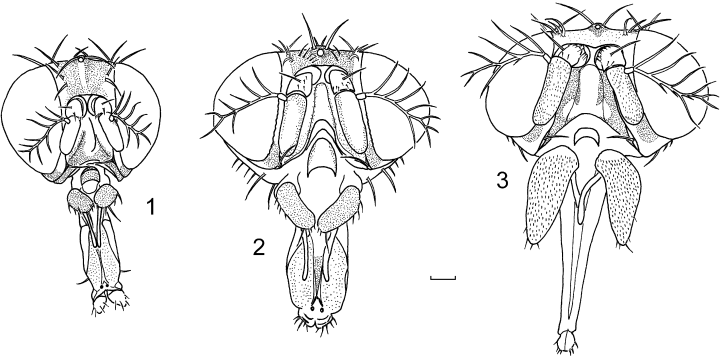
Heads of the Zygothrica samoaensis species group (frontal view). 1Z. australiaensis sp. nov. (samoaensis subgroup); 2Z. triscutellaris sp. nov. (fijiana subgroup); 3Z. quintamaculata sp. nov. (leptorostra subgroup). Scale line: 0.1 mm.
Distribution. The range is restricted to the Indo-Pacific region, from Thailand (westernmost) and southern China (northernmost) to French Polynesia (easternmost) and Fiji (southernmost). The distributions of the three subgroups are mostly overlapping (4-48).
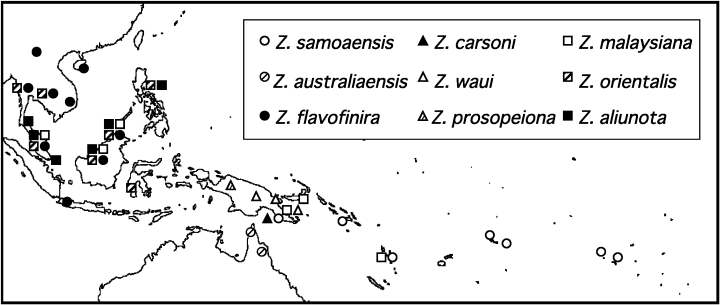
Species distribution of the Zygothrica samoaensis subgroup.
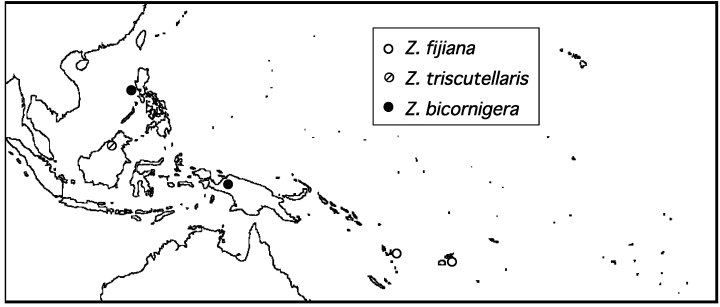
Species distribution of the Zygothrica fijiana subgroup.
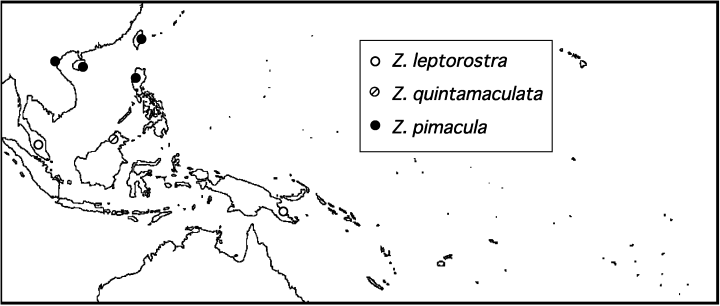
Species distribution of the Zygothrica leptorostra subgroup.
Zygothrica samoaensis species subgroup
Diagnosis. Prescutellar setae moderately developed; epandrium without ventral lobe (5–8-29–33); paramere bare (9–13-29–33).
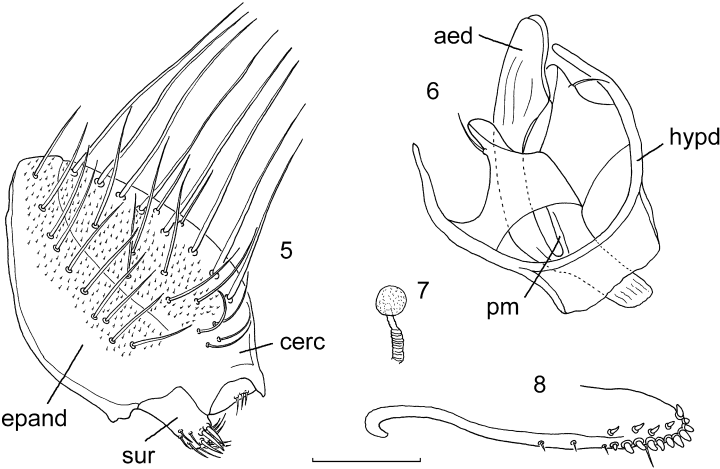
Zygothrica samoaensis Malloch (male and female from Apia, West Samoa). 5 Periphallic organs (epand: epandrium, sur: surstylus and cerc: cercus, in lateral view); 6 phallic organs (hypd: hypandrium, pm: parameres and aed: aedeagus, in lateroventral view); 7 spermatheca; 8 oviscapt (lateral view). Scale line: 0.1 mm.

Zygothrica australiaensis sp. nov. (male and female paratypes from Cape Tribulation, Queensland, Australia). 9 Periphallic organs (ventral view); 10,11 phallic organs (10: part, lateral view; 11: ventral view); 12 spermatheca; 13 oviscapt (lateral view). Scale line: 0.1 mm.
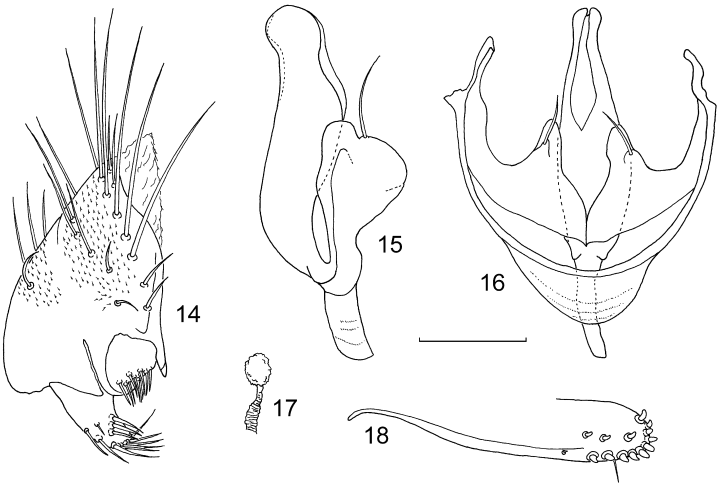
Zygothrica flavofinira Takada (male from Poring, Sabah, Malaysia; female from Khao Yai, Thailand). 14 Periphallic organs (ventral view); 15,16 phallic organs (15: part, lateral view; 16: ventral view); 17 spermatheca; 18 oviscapt (lateral view). Scale line: 0.1 mm.

Zygothrica malaysiana Grimaldi (male from Lambir, Sarawak, Malaysia; female from Poring, Sabah, Malaysia). 19 Periphallic organs (ventral view); 20,21 phallic organs (20: part, lateral view; 21: ventral view); 22 spermatheca; 23 oviscapt (lateral view). Scale line: 0.1 mm.

Zygothrica orientalis Grimaldi (male and female from Lambir, Sarawak, Malaysia). 24 Periphallic organs (ventral view); 25,26 phallic organs (25: part, lateral view; 26: ventral view); 27 spermatheca; 28 oviscapt (lateral view). Scale line: 0.1 mm.
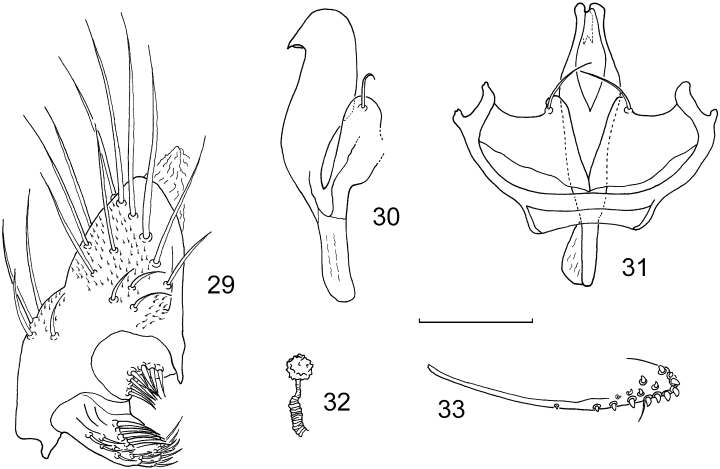
Zygothrica aliunota Grimaldi (male from Lambir, Sarawak, Malaysia; female from Tawau, Sabah, Malaysia). 29 Periphallic organs (ventral view); 30,31 phallic organs (30: part, lateral view; 31: ventral view, male from Kubah, Sarawak, Malaysia); 32 spermatheca; 33 oviscapt (lateral view). Scale line: 0.1 mm.
Common characters. Head: Ocellar triangle small, black; frontal vittae dark brown, anteriorly paler, separated by yellowish median vitta; fronto-orbital plates light brown, dorsally separated from frontal vittae by conspicuous black line running down to base of anterior reclinate orbital seta; median occipital sclerite dark brown; antennal scape dark to yellowish brown; pedicel ochre to dark brown, with two long setae and a few smaller ones; first flagellomere yellow to dark brown; clypeus ochre to dark brown, protruding; palpus horizontally flat, with one long subapical seta, several moderately long ones along apical to lateral margin and shorter ones on dorsal and ventral surfaces; lacinia dark brown; prementum brown, sclerotized; labellum brown, with several long setae. Thorax: Postpronotal setae three (one dorsal shorter); acrostichal setulae in eight irregular rows; two pairs of scutellar setae; anterior katepisternal seta thin; legs white. Abdomen: Tergites I–IV dorsally entirely black, laterally pale yellow to white. Male terminalia: Epandrium pubescent except for ventral portion and anterolateral margin; cercus pubescent except for ventral portion, fused to caudoventral portion of epandrium, with apically pointed bare hypoproctal plate and ventral lobe; paramere very thin; hypandrial mediolateral processes apically round in lateral view, each bearing paramedian seta subapically. Female terminalia: Spermathecal capsule small, less sclerotized; duct not introverted.
Distribution. From Thailand (westernmost) and southern China (northernmost) to French Polynesia (south-easternmost; Fig. 4).
Zygothrica samoaensis Malloch (Figs 5–8)
Zygothrica samoaensis Malloch (1934): 278; Harrison (1954): 114; Wheeler and Kambysellis (1966): 542; Takada (1976): 66; Grimaldi (1990): 9.
Diagnosis. Proboscis long, prem/o 0.78–0.97 in male, 0.80–1.03 in female; foreleg femur with a row of six to nine conspicuous dark setae on ventral margin; abdominal tergite VI medially black; cercus without ventral setation, with two to three thin setae on small ventral lobe (Fig. 5); aedeagus more or less hunchbacked ventro-subapically and round, unadorned apically in lateral view (Fig. 6).
Male. Head: Ocellar setae slightly thinner than orbital and vertical setae. Anterior reclinate orbital seta midway between proclinate and posterior reclinate; posterior reclinate orbital seta slightly closer to anterior reclinate orbital than to inner vertical. Face black at oral margin and progressively paler in rising antennal fossae. Lacinia 0.6–0.8 as long as maximum diameter of eye; labellum as narrow as apical part of prementum. Thorax: Scutum and scutellum uniformly black, but more brownish, with median and paramedian vittae visible on scutum in specimens from Tutuila. Presutural supra-alar seta nearly as long as posterior notopleural seta. Abdomen: Tergite V with white side extension dorsally visible; median black patch on tergite VI reduced more in male. Terminalia (Figs 5,6): Epandrium with nine to ten setae per side. Cercus with 20–22 setae. Aedeagus fusiform in ventral view; apodeme short, laterally flat.
Measurements: BL 1.95–2.15 mm, ThL 1.04–1.34 mm, WL 2.02–2.24 mm, WW 0.90–0.99 mm.
Indices: arb 5–6/2–3, FW/HW 0.40–0.46, ch/o 0.07–0.12, palp/o 0.33–0.46, prorb 0.81–1.25, rcorb 0.58–0.90, dcl 0.33–0.55, sctl 0.76–0.92, sterno 0.50–0.71, orbito 1.14–1.79, dcp 0.21–0.32, sctlp 1.05–1.50, C 1.75–2.24, 4c 1.02–1.26, 4v 1.71–2.00, 5x 1.43–1.87, ac 2.72–3.75, M 0.49–0.60, C3F 0.48–0.64.
Female. Head, thorax and abdomen as in male. Terminalia (Figs 7,8): Oviscapt with three to four lateral and approximately 11 peg-like and three minute marginal ovisensilla. Spermathecal capsule globular, slightly granulated on surface.
Measurements: BL 2.40 mm in holotype (1.96–2.38), ThL 1.36 mm (1.11–1.32), WL 2.10 mm (2.10–2.37), WW 1.19 mm (0.99–1.04).
Indices: arb 5/2 (4–6/1–2), FW/HW 0.42 (0.40–0.44), ch/o 0.08 (0.07–0.10), palp/o 0.50 (0.38–0.49), prorb 1.00 (0.80–1.08), rcorb 0.86 (0.61–0.92), dcl 0.56 (0.46–0.52), sctl 1.04 (0.82–0.96), sterno 0.75 (0.54–0.69), orbito 1.50 (1.11–1.67), dcp 0.24 (0.18–0.26), sctlp 1.36 (1.20–1.45), C 2.13 (1.85–2.17), 4c 1.02 (1.04–1.12), 4v 1.74 (1.75–2.02), 5x 1.75 (1.69–2.00), ac 3.13 (3.23–3.92), M 0.61 (0.54–0.63), C3F 0.55 (0.43–0.64).
Specimens examined. West Samoa: Upolu Island: 1♀ (holotype of Z. samoaensis: BMNH and BM 1934–97), labeled “Upolu, Malololelei, West Samoa, 2000 ft, 30.xi.1924, P.A. Buxton and G.H. Hopkins, presented by P.A. Buxton”; 1♀ (BISH), same collection data as holotype; 2♂1♀ (SEHU), Apia, 13.vii.1973, H. Takada, ex Ganoderma sp. fungi; Savai’i Island: 1♂ (allotype of Z. samoaensis: BISH), Safune, 12.v.1924, E.H. Bryan Jr. collector, presented by P.A. Buxton; 2♂1♀ (paratypes of Z. samoaensis: BMNH), same collection data as allotype; 1♂ (paratype of Z. samoaensis: BMNH), same collection data but 11.v.1924, lower forest 1000–2000 ft; 1♀ (BMNH), 2♂2♀ (BISH), same collection data as allotype; 4♂4♀ (BISH), same collection data but 11.v.1924, lower forest 1000–2000 ft; 3♂1♀, 1 undetermined sex (BISH), Palauli, ii.1955, N.L.H. Krauss. American Samoa: 3♂4♀ (BISH), V. Malaiaimi, Tutuila Island, x.1954, C.P. Hoyt.
Distribution. Papua New Guinea, Solomon Islands, Samoa Islands, French Polynesia, Vanuatu?
Remarks. Grimaldi (1990) questioned the identity of the specimens described by Takada (1976) based on drawings of the male terminalia, especially the shape of the distiphallus. We examined the same specimens as used by Takada (1976) for the description, and confirmed that the morphology of the male terminalia of the specimens perfectly agrees with that of the dissected paratype and with the descriptions and drawings of Z. samoaensis by Wheeler and Kambysellis (1966) and Grimaldi (1990). However, three males and four females from Vanuatu (New Hebrides; BMNH), which were determined as being Z. samoaensis by D. Grimaldi, are Z. malaysianaGrimaldi, 1990. The distribution of this species on Vanuatu should therefore be reconfirmed by examining the other specimens from there in the light of this new finding. Moreover, Australian specimens assigned to Z. samoaensis by Bock (1982) and Grimaldi (1990) are considered to be another species, which is described hereafter as a new species.
Zygothrica australiaensis sp. nov. (1–3, 5–8, 9–13)
Zygothrica samoaensis: Bock (1982): 150, 152, figs 116–118; McEvey & Bock (1982): 693, 707; Bock (1989): 177; Grimaldi (1990): 9 (part).
Diagnosis. Proboscis moderately long, prem/o 0.63 for holotype (0.53–0.69 for male paratypes, 0.57–0.76 for female paratypes); foreleg femur with a row of thin yellow setae on ventral margin; abdominal tergite VI entirely white; cercus with nine to 11 stout short setae ventrally and six to eight stout setae on relatively large ventral lobe (Fig. 9).
Male. Head (Fig. 1): Ocellar setae slightly thinner than orbital and vertical setae. Anterior reclinate orbital seta usually closer to proclinate than to posterior reclinate; posterior reclinate orbital seta midway between anterior reclinate orbital and inner vertical. Face darker at oral margin and progressively paler in rising antennal fossae; carina yellow. Palpus short. Lacinia 0.45–0.60 as long as maximum diameter of eye; labellum slightly wider than apical part of prementum. Thorax: Scutum and scutellum uniformly black. Presutural supra-alar seta shorter than posterior notopleural seta; two pairs of prescutellar setae only slightly longer than acrostichal setulae. Abdomen: Tergite V with white side extension dorsally visible. Terminalia (Figs 9–11): Epandrium with seven to 11 setae per side. Surstylus approximately twice as long as wide, with a row of approximately three stout prensisetae submedially and 10–13 thinner setae near ventral to apical margin on the distal half. Cercus with 14–18 setae. Aedeagus fusiform in ventral view, not so hunchbacked ventro-subapically and apically round and unadorned in lateral view; apodeme short, laterally flat.
Measurements: BL 1.90 mm (1.42–2.20), ThL 1.05 mm (0.80–1.13), WL 1.95 mm (1.61–2.24), WW 0.88 mm (0.70–1.01).
Indices: arb 5/2 (4–5/1–2), FW/HW 0.40 (0.38–0.48), ch/o 0.10 (0.08–0.11), palp/o 0.33 (0.30–0.41), prorb 1.04 (0.95–1.13), rcorb 0.74 (0.55–0.85), dcl 0.40 (0.35–0.58), sctl 0.77 (0.79–0.94), sterno 0.53 (0.32–0.53), orbito 1.06 (1.50–1.89), dcp 0.29 (0.25–0.42), sctlp 1.41 (1.00–1.29), C 1.85 (1.66–2.17), 4c 1.33 (1.00–1.43), 4v 2.33 (1.75–2.27), 5x 1.44 (1.57–1.89), ac 3.64 (3.00–4.25), M 0.60 (0.50–0.67), C3F 0.57 (0.52–0.68).
Female. Head, thorax and abdomen as in male. Terminalia (Figs 12,13): Oviscapt with three to five lateral and 10–15 marginal peg-like ovisensilla. Spermathecal capsule globular, completely smooth on surface.
Measurements: BL 1.76–2.50 mm, ThL 0.97–1.27 mm, WL 1.85–2.37 mm, WW 0.80–1.06 mm.
Indices: arb 4–5/1–2, FW/HW 0.39–0.44, ch/o 0.07–0.09, palp/o 0.29–0.38, prorb 0.92–1.04, rcorb 0.58–0.90, dcl 0.35–0.49, sctl 0.76–0.92, sterno 0.38–0.50, orbito 1.50–1.82, dcp 0.23–0.29, sctlp 1.26–1.50, C 1.81–2.03, 4c 1.18–1.36, 4v 2.06–2.36, 5x 1.50–1.80, ac 3.42–3.86, M 0.55–0.66, C3F 0.50–0.60.
Holotype. Australia:♂ (AM), labeled “Trinity Beach, Northern Queensland, Australia, 16°47′S−146°39′E, 6.xii.1998, swept, coll. S.F. McEvey 13712.”
Paratypes. Australia: 10♂3♀ (2♂ K194421, 194424, 2♀ K194422, 194423 in AM; 3♂ S.F. McEvey 13708, 13711, 13713, 1♀ S.F. McEvey 13707 in BISH; 5♂ S.F. McEvey 13714–13716, 13720, 13740 in BMNH), same collection data as holotype; 22♂3♀ (13♂ K194425–194427, 194429, 194431–194433, 194435–194440, 2♀ K194428, 194430 in AM; 2♂ S.F. McEvey 23203, 23204 in NMNH; 2♂ S.F. McEvey 23205, 23206 in NSMT; 1♂ S.F. McEvey 23202 in BISH; 4♂ S.F. McEvey 23207–23210, 1♀ S.F. McEvey 23211 in SEHU), Tully River, West of Mount Cullumbullum, northern Queensland, 22.iv.1980, S.F. McEvey, ex fungus (rainforest); 8♂1♀ (QM), Cape Tribulation, northern Queensland, 16.iii.2000, M.J. Toda, ex fungi; 4♂2♀ (QM), same collection data but 22.iii.2000; 2♂ (UQIC), same collection data but 22.iii.2000, ex fallen logs; 1♂ (UQIC), same collection data but 28.iii.2000, ex fallen logs; 4♂4♀ (UQIC), same collection data but 30.iii.2000.
Other specimens examined. (Dr McEvey has kindly examined additional specimens at AM and has confirmed that they conform to our description and that the diagnostic characters we propose are reliable across a long series of specimens.) Australia: Northern Queensland: 5♂6♀, Cape Tribulation, 16°07′S 145°26′E, 6–20.i.2003, S.F. McEvey, ex fungus; 1♂1♀, Mossman Gorge 5 km W of Mossman, 28.iv.1980, S.F. McEvey; 2♂5♀, Mossman National Park, 1.i.1984, P. Parsons, off forest fungi; 1♂, Kuranda, 19.v.1958, D.K. McAlpine; 2♀, Mulgrave River Forestry Road, 14 km and 18 km S of Gordonvale, 26–27.iv.1980, S.F. McEvey, swept (rainforest); 1♂, Maple Creek W of Innisfail, 17°41′S 145°43′E, 23.iv.1980, S.F. McEvey; 1♂, Palmerston National Park S of Wallacha Falls–Tchupalla Falls track, 10.i.1979, P.A. Parsons, swept on or near fungi; 1♂, Palmerston National Park along track near 2215 ft sign, inland from Hennietta Creek, 24.ii.1979, P.A. Parsons, off or near fungi; 8♂8♀, Palmerston National Park, vi.1983, P.A. Parsons, off fungi.
Etymology. Referring to the country, Australia, of the type locality.
Distribution. Australia (northern Queensland).
Remarks. Bock (1982) assigned the specimens collected from Queensland, Australia, to Z. samoaensis apparently without examining Samoan specimens, although he commented that “The Australian specimens differ slightly from those described previously for this species in the length of the anterior reclinate orbital bristle (as long as the posterior reclinate orbital bristle in the Samoan specimens, shorter in the Australian specimens), but the Australian specimens match the descriptions of the Samoan ones in other respects, and the male genitalia of the Australian specimens are in good agreement with those figured by Wheeler and Kambysellis (1966).” In the original description of Z. samoaensis, Malloch (1934; fig. 5) shows long subequal reclinate orbital setae, but in the text he describes the anterior one as being “shorter than the others.”Takada (1976) also described Samoan specimens as having the anterior reclinate orbital seta shorter than the posterior one. We have found, however, that the rcorb values overlap in Samoan and Australian specimens, and this is therefore not a useful character. Instead we have found that the short stout setae on the ventral portion of the cercus, which are clearly shown by Bock (1982; fig. 117), are useful in distinguishing between Australian and Samoan specimens. These short stout setae are not indicated in the figures of a Samoan specimen by Wheeler and Kambysellis (1966). Grimaldi (1990) examined Samoan and Australian specimens and showed variation in the number and thickness of setae on the ventral lobe of the cercus in his figures 13 and 14; he evidently treated this as acceptable intraspecific variation. Bock (1982) also described the entirely pale tan abdominal tergite VI, which differs from the black tergite VI found by us and Takada (1976) in Z. samoaensis. Our careful re-examination of Z. samoaensis from Samoa and our finding that the length of the prementum plate and the setation on the ventral margin of the foreleg femur are diagnostic, in addition to the differentiation of genitalia, led us to conclude that the Australian specimens belong to a separate species different from, but closely related to, Z. samoaensis.
Zygothrica flavofinira Takada (Figs 14–18)
Zygothrica flavofinira Takada (1976): 70.
Zygothrica vietnamensis Grimaldi (1990): 15. Syn. nov.
Zygothrica orientalis Grimaldi (1990): 8 (part, misidentified).
Zygothrica malaysiana Grimaldi (1990): 9 (part, misidentified).
Diagnosis. Gena and anterior part of face largely black; scutum brown to black, with median (running through entire length) and a pair of paramedian (running just inside dorsocentral lines from anterior margin to level of anterior dorsocentral setae), light brown vittae; cercus with six to ten stout setae on ventral lobe (Fig. 14); aedeagus apically round, unadorned in lateral view (Fig. 15).
Male. Head: Ocelli yellow (reddish in another specimen). Thorax: Presutural supra-alar seta as long as posterior notopleural. Abdomen: Tergite V dorsally widely black, with white side extension dorsally visible; tergite VI with faint brown triangular patch medially. Terminalia (Figs 14–16): Epandrium with six to 11 setae per side. Surstylus with row of three or four stout prensisetae submedially and seven to ten thinner setae near ventral to apical margin on distal half. Cercus with 15–19 setae; ventral portion bare, with neither pubescence nor setation. Aedeagus fusiform in ventral view, more or less hunchbacked ventro-subapically in lateral view; apodeme short, laterally flat.
Measurements: BL 1.61–2.95 mm, ThL 0.97–1.58 mm, WL 1.88–2.92 mm, WW 0.83–1.30 mm.
Indices: arb 5–8/2–3, FW/HW 0.35–0.47, ch/o 0.08–0.11, prem/o 0.59–0.78, palp/o 0.35–0.43, prorb 0.82–1.25, rcorb 0.60–0.74, dcl 0.48–0.60, sctl 0.84–0.95, sterno 0.35–0.69, orbito 1.13–1.64, dcp 0.19–0.33, sctlp 1.09–1.29, C 1.86–2.56, 4c 0.86–1.13, 4v 1.63–1.88, 5x 1.37–1.67, ac 3.06–3.86, M 0.44–0.53, C3F 0.57–0.67.
Female. Head, thorax and abdomen as in male. Terminalia (Figs 17,18): Oviscapt with three to six lateral and ten to 17 marginal peg-like ovisensilla. Spermathecal capsule globular, irregularly wrinkled on surface.
Measurements: BL 1.92 mm (2.12–3.26), ThL 1.26 mm (1.20–1.52), WL 2.08 mm (2.23–2.97), WW 0.94 mm (0.91–1.38).
Indices: arb 4/1 (5–7/1–2), FW/HW 0.38 (0.37–0.44), ch/o 0.08 (0.07–0.12), prem/o (0.67–0.89), palp/o (0.35–0.41), prorb 0.69 (0.75–1.07), rcorb 0.77 (0.47–0.69), dcl (0.44–0.59), sctl (0.80–1.00), sterno 0.47 (0.52–0.65), orbito 1.70 (1.21–1.67), dcp (0.23–0.32), sctlp (1.15–1.81), C 2.10 (1.98–2.61), 4c 1.05 (0.91–1.13), 4v 1.86 (1.82–2.05), 5x 1.64 (1.49–1.76), ac 3.55 (3.00–4.00), M 0.49 (0.47–0.58), C3F (0.55–0.68).
Specimens examined. Malaysia: 1♀ (holotype of Z. flavofinira: SEHU), labeled “Gombak, near Kuala Lumpur, Malaysia, 3.vii.1972, H. Takada”; 1♀, Lambir, Sarawak, 14.ix.1998, S.R. Prigent, ex fungi; Sabah: 2♂1♀, Poring, 30.xii.1998, M.J. Toda, ex fungi; 1♀, same collection data but 31.xii.1998, ex fallen logs; 1♂2♀, Tawau, 16.iii.2002, M.J. Toda, ex fungi. Vietnam: 1♂ (holotype of Z. vietnamensis: BISH), Fyan, 900–1000 m, 11.vii−9.viii.1961, N.R. Spencer; 1♀ (paratype of Z. vietnamensis: BISH), Ban MeThuot, 500 m, 20–24.xii.1960, C.M. Yoshimoto. Thailand: 1♂ (NSMT, determined as Z. orientalis by D. Grimaldi), Erawan Water Fall, 10.ix.1975, H. Kurahashi; Khao Yai, S.R. Prigent: 5♂7♀, 7.viii.1997, ex Russula sp.; 4♂2♀, 8.viii.1997, ex Amanita sp.; 6♂5♀, 10.viii.1997, ex Entoloma sp.; 4♂6♀, 12.viii.1997, ex fungi; 4♂4♀, same collection data but ex Marasmius sp.; 1♂, same collection data but ex Russula sp.; 9♂10♀, 13.viii.1997, ex Termitomyces sp.; 26♂12♀, 14.viii.1997, ex Amanita sp.; 27♂38♀, 15.viii.1997, ex fungi; 1♂, same collection data but ex Termitomyces sp. Indonesia: 1♂, Cibodas, Java, 28.xi.1996, M.J. Toda, ex fungi. China: 4♂13♀, Jianfenling, Ledong County, Hainan Island, 800 m, 24.ix.1993, M.J. Toda; Xishuangbanna, Yunnan: 42♂11♀, Menglun, 4.xi.2001, H. Watabe; 4♂9♀, Menglun, 12.viii.2002, M.J. Toda; 3♂1♀, Mengla, 5–6.xi.2001, H. Watabe.
Distribution. Malaysia (peninsular Malaysia, Sabah new record; Sarawak new record); Indonesia new record (Java); Thailand new record; Vietnam (cited as Z. vietnamensis); China new record (Hainan Island, Yunnan).
Remarks. This species most closely resembles Z. samoaensis in having the bare ventral portion of cercus and the ventro-subapically hunchbacked aedeagus, but can be clearly distinguished from it by having more and stouter setae on the cercal ventral lobe, the darker face and the design of pigmentation on the tergite VI. Although the scutal vittae are not so conspicuous, even in the holotype, such vittae are not, or hardly, observed in other species of the samoaensis subgroup, except for Zygothrica carsoni Grimaldi, 1990, from Papua New Guinea and some specimens of Z. samoaensis from Tutuila Island. Zygothrica carsoni can be easily distinguished from others by the small brown spots at the apices of R2+3, R4+5 and M1 (Grimaldi 1990). Examining the male holotype and a female paratype of Z. vietnamensis Grimaldi, 1990, we confirmed the presence of light brown vittae on the scutum of both specimens and found no morphological differences between the female paratype of Z. vietnamensis and the female holotype of Z. flavofinira. Accordingly, we concluded that Z. vietnamensis Grimaldi, 1990, is a junior synonym of Z. flavofinira Takada, 1976. Furthermore, examining three male and two female specimens determined as Z. orientalis by Grimaldi (1990) on loan from NSMT, we found that one male is Z. flavofinira. In addition, a male paratype of Z. malaysiana Grimaldi, 1990, which was used for drawing the phallic organs by Grimaldi (1990; fig. 17), should be Z. flavofinira. The apical part of its aedeagus is smooth, not adorned with hooks (cf. the description of Z. malaysiana), although the hypandrial and aedeagal apodemes are almost undeveloped, which Grimaldi (1990) designated as the diagnosis for Z. malaysiana. It is, however, known that these apodemes develop with aging even after the adult eclosion (Okada 1953). We found a large variation in the development of these apodemes among male specimens collected from the same locality and showing no differences in other morphological characters, implying their different ages.
Zygothrica carsoni Grimaldi
Zygothrica carsoni Grimaldi (1990): 12.
Diagnosis. (Modified from Grimaldi 1990.) Scutum coffee-brown with a pair of light paramedian incomplete vittae; wing with faint brown spots at apices of R2+3, R4+5 and M1.
Distribution. Papua New Guinea.
Zygothrica waui Grimaldi
Zygothrica waui Grimaldi (1990): 11.
Zygothrica“waui”Grimaldi (1987): 140, 148 (placement of undescribed species).
Diagnosis. (Modified from Grimaldi 1990.) Hypandrial mediolateral processes very broad; aedeagus with distinctive swollen apical labia.
Specimens examined. Papua New Guinea: 1♂ (paratype of Z. waui: NSMT), Wau, 4.ix.1977, T. Okada; 1♂ (paratype of Z. waui: NSMT), same collection data but 26.ix.1977; 1♀ (paratype of Z. waui: NSMT), Bulolo, 23.viii.1977, T. Okada; 1♂ (BMNH, B.M. 1933–427), Kokoda, 1200 ft, vii.1933, L.E. Cheesman; 1♂ (BISH), Mount Missim, Morobe District, Wau, 1600 m, 17.iii.1966, J.L. Gressitt.
Distribution. Papua New Guinea.
Remarks. Grimaldi (1990) assigned six male and three female specimens to Z. waui. The diagnostic characters lie in the male terminalia, but the holotype has not been dissected. We have checked the terminalia of five other males, and determined that one of them is Z. malaysiana Grimaldi, 1990, and that the others, including the two paratypes, belong to three different species. As we were not able to check the holotype (deposited at the American Museum of Natural History [AMNH], New York, USA), we cannot designate any of these males as Z. waui. Only the dissection of holotype terminalia can specify the diagnosis of Z. waui and consequently allow the determination of which males belong to new species. Given these conditions, we refrain from describing the putative new species.
Zygothrica prosopeiona Grimaldi
Zygothrica prosopeiona Grimaldi (1990): 13.
Diagnosis. (Modified from Grimaldi 1990.) Aedeagus with conspicuous retrorse hook dorso-apically; black-brown band lying on oral margin of face and over ventral half of carina.
Specimen examined. Indonesia: Irian Jaya (New Guinea): 1♂ (holotype of Z. prosopeiona: BISH), labeled “NW, Swart Valley, Karubaka, New Guinea, 1450 m, 6.xi.1958, J.L. Gressitt.”
Distribution. Indonesia (Irian Jaya).
Zygothrica malaysiana Grimaldi (Figs 19–23)
Zygothrica malaysiana Grimaldi (1990): 9.
Zygothrica“malaysiana”: Grimaldi (1987): 140, 148 (placement of undescribed species).
Zygothrica britannia Grimaldi (1990): 17. Syn. nov.
Zygothrica samoaensis: Grimaldi (1990): 9 (part, misidentified).
Zygothrica waui Grimaldi (1990): 11 (part, misidentified).
Diagnosis. Prementum mostly dark brown, but ochre to white at proximal end, particularly in male; anterior margin of dark brown band on abdominal tergite V narrower than and as wide as posterior margin of dark brown band on tergite IV in male and female, respectively; female tergite VI usually with median brown patch; stout setae arranged obliquely on cercal ventral lobe (Fig. 19); surstylus approximately twice as long as wide, wrinkled on proximal outer surface (Fig. 19); distiphallus adorned with a pair of retrorse hooks, of which dorsosubapical margin concave in lateral view (Fig. 20).
Male. Head: Eye dull red-brown. Ocellar triangle black between ocelli, ochre in periphery; ocellar setae extended nearly to level of bases of proclinate orbitals. Anterior reclinate orbital seta nearly midway between proclinate and posterior reclinate orbitals; posterior reclinate orbital slightly closer to anterior reclinate orbital than to inner vertical. Inner vertical seta slightly inside to line of ipsilateral orbitals. Face ochre to light brown; carina pale. Lacinia approximately 0.6 as long as maximum diameter of eye. Thorax: Scutum and scutellum uniformly dark brown. Subscutellum and postnotum light brown. Presutural supra-alar seta shorter than posterior notopleural; one or two pairs of prescutellar setae only slightly longer than acrostichal setulae. Abdomen: Tergite VI pale yellow. Terminalia (Figs 19–21): Epandrium with four to eight setae per side. Surstylus with row of three or four stout prensisetae submedially and 13–23 thinner setae near ventral to apical margin on distal half. Cercus with 13–20 setae and ventral lobe bearing four to 10 stout setae. Aedeagal apodeme variable in length (probably according to age), laterally flat.
Measurements: BL 1.97 mm (2.09–2.53), ThL 0.98 mm (0.95–1.29), WL 1.85 mm (1.70–2.23), WW 0.80 mm (0.76–0.94).
Indices: arb 4–5/2 (4–7/1–2), FW/HW 0.44 (0.38–0.43), ch/o 0.08 (0.07–0.12), prem/o 0.70 (0.69–0.80), palp/o 0.43 (0.36–0.45), prorb 0.95 (0.83–1.18), rcorb 0.50 (0.58–0.81), dcl 0.51 (0.50–0.65), sctl 0.72 (0.79–1.23), sterno 0.47 (0.38–0.56), orbito 1.36 (1.23–1.75), dcp 0.33 (0.21–0.33), sctlp 1.38 (1.17–1.60), C 1.35 (1.42–1.77), 4c 1.38 (1.18–1.38), 4v 2.00 (1.86–2.41), 5x 1.88 (1.55–1.90), ac 4.15 (3.45–4.63), M 0.53 (0.51–0.62), C3F 0.58 (0.54–0.64).
Female. Head, thorax and abdomen as in male. Terminalia (Figs 22,23): Oviscapt with four to seven lateral and approximately nine to 11 peg-like and two minute marginal ovisensilla. Spermathecal capsule globular, irregularly wrinkled on surface.
Measurements: BL 1.95–2.61 mm, ThL 0.89–1.27 mm, WL 1.67–2.39 mm, WW 0.74–1.23 mm.
Indices: arb 4–6/1–2, FW/HW 0.40–0.46, ch/o 0.07–0.13, prem/o 0.72–0.96, palp/o 0.38–0.50, prorb 0.91–1.11, rcorb 0.58–0.86, dcl 0.42–0.55, sctl 0.74–0.92, sterno 0.50–0.57, orbito 1.14–1.70, dcp 0.24–0.48, sctlp 1.29–1.64, C 1.35–2.02, 4c 1.13–1.44, 4v 1.86–2.32, 5x 1.58–2.00, ac 3.91–5.86, M 0.54–0.67, C3F 0.53–0.63.
Specimens examined. Malaysia: 1♂ (holotype of Z. malaysiana: NMNH), labeled “14 km W Kundasang, Sabah, Malaysia, 1450 m, 13.viii.1983, G.F. Hevel & W.E. Steiner”; 1♂1♀ (paratypes of Z. malaysiana: NMNH), same collection data as holotype; Poring, Sabah, M.J. Toda: 2♂5♀, 30.xii.1998; 9♂6♀, 28.ix.1999; 11♂12♀, 27.vi.2000; Lambir, Sarawak, S.R. Prigent: 1♀, 7.ix.1998; 1♂, 13.ix.1998; Lambir, Sarawak, M.J. Toda: 3♀, 8.i.1999, ex fungi; 71♂57♀, 10.i.1999, ex fungi; 24♂18♀, 11.i.1999, ex a large patch of white Agaricales; 15♂10♀, 11.i.1999, ex fungi; 4♂5♀, 13.i.1999, ex white Agaricales. Papua New Guinea: 1♂ (BMNH, BM1933-427), Kokoda, 1200 ft, iv.1933, L.E. Cheesman, det. by D. Grimaldi as Z. waui. Vanuatu (New Hebrides): 1♂ (holotype of Z. britannia: BISH), labeled “N Lakatoro, Malekula, 22–30.ix.1967, J. & M. Sedlacek”; 3♂3♀ (paratypes of Z. britannia: BISH), same collection data as holotype; det. by D. Grimaldi as Z. samoaensis (BMNH): 3♂1♀ (BM1929-234), Ounua, Malekula, ii.1929, Miss L.E. Cheesman; 2♀ (BM1929-343), same collection data but iii–iv.1929; 1♀ (BM1929-371), same collection data but iv–v.1929.
Distribution. Malaysia (peninsular Malaysia, Sabah, Sarawak new record), Papua New Guinea (cited as Z. britannia and Z. waui), Vanuatu (cited as Z. britannia and Z. samoaensis).
Remarks. While examining the holotype and the paratype specimens of Z. malaysiana, we found that the structure of male terminalia is definitely different from the description by Grimaldi (1990), which was possibly based on another paratype, which we did not examine. The aedeagus is characteristically adorned with a pair of retrorse hooks dorsosubapically, whereas Grimaldi (1990) wrote “Distiphallus unadorned, tapered apicad, then with an apical knob” (see Grimaldi 1990; fig. 17). Although the tip of the aedeagus is unfortunately broken and partly missing in the holotype, the shape of the broken line certainly shows the presence of retrorse hooks there. Furthermore, a drawing of a very similar aedeagus adorned with retrorse hooks was presented by Grimaldi (1990: fig. 30) for another species, Z. britannia, collected from Vanuatu (New Hebrides) and Papua New Guinea. The male terminalia of the examined Z. britannia paratype was the same in the detailed structure as that of Z. malaysiana, and we could not find any discriminative morphological differences between the type specimens of these two species other than a slight one in coloration on the abdominal tergites V and VI: they are slightly darker in Z. britannia than in Z. malaysiana. Accordingly, we synonymized Z. britannia Grimaldi, 1990, under Z. malaysiana Grimaldi, 1990.
Zygothrica orientalis Grimaldi (Figs 24–28)
Zygothrica orientalis Grimaldi (1990): 8.
Zygothrica“orientalis”Grimaldi (1987): 140, 148 (placement of undescribed species).
Diagnosis. Prementum mostly yellowish brown, but dark brown only at apical end in male, slightly darker in female; anterior margin of black band on abdominal tergite V as wide as posterior margin of black band on tergite IV in both sexes; female tergite VI sometimes only faintly light brown on medioposterior margin; stout setae arranged somewhat horizontally on cercal ventral lobe (Fig. 24); surstylus approximately 1.5 times as long as wide, not wrinkled on outer surface (Fig. 24); distiphallus adorned with a pair of retrorse hooks, of which dorsosubapical margin nearly straight in lateral view (Fig. 25).
Male. Head: Posterior reclinate orbital seta approximately midway between anterior reclinate orbital and inner vertical. Lacinia approximately 0.7 as long as maximum diameter of eye. Thorax: Presutural supra-alar seta shorter than posterior notopleural. Abdomen: Tergite VI white. Terminalia (Figs 24–26): Epandrium with five to nine setae per side. Surstylus with a row of two to four stout prensisetae submedially and 11–17 thinner setae near ventral to apical margin on distal half. Cercus with 15–19 setae and ventral lobe bearing four to eight stout setae. Aedeagal apodeme variable in length (probably according to age), laterally flat.
Measurements: BL 1.67–2.58 mm, ThL 0.88–1.21 mm, WL 1.59–2.21 mm, WW 0.73–0.97 mm.
Indices: arb 5–7/1–2, FW/HW 0.37–0.45, ch/o 0.08–0.13, prem/o 0.64–0.90, palp/o 0.42–0.48, prorb 0.80–1.10, rcorb 046–0.80, dcl 0.38–0.69, sctl 0.73–0.91, sterno 0.43–0.69, orbito 1.40–1.73, dcp 0.21–0.33, sctlp 1.00–1.43, C 1.45–1.94, 4c 1.03–1.40, 4v 1.74–2.21, 5x 1.46–2.00, ac 3.23–4.47, M 0.48–0.61, C3F 0.59–0.66.
Female. Head, thorax and abdomen as in male. Terminalia (Figs 27,28): Oviscapt with two to five, rarely six lateral and eight to 11 peg-like and two minute marginal ovisensilla. Spermathecal capsule globular, irregularly wrinkled on surface.
Measurements: BL 1.68–2.73 mm, ThL 0.85–1.27 mm, WL 1.65–2.42 mm, WW 0.73–1.06 mm.
Indices: arb 4–6/1–2, FW/HW 0.39–0.43, ch/o 0.08–0.12, prem/o 0.75–0.88, palp/o 0.38–0.47, prorb 0.85–1.13, rcorb 0.62–0.91, dcl 0.42–0.62, sctl 0.67–0.94, sterno 0.50–0.67, orbito 1.40–2.00, dcp 0.24–0.29, sctlp 1.25–1.50, C 1.47–1.86, 4c 1.20–1.47, 4v 1.81–2.26, 5x 1.30–1.80, ac 3.81–5.00, M 0.45–0.63, C3F 0.53–0.66.
Specimens examined. Indonesia: Sulawesi: 1♀ (NSMT, determined by D. Grimaldi), Marino, 9.xii.1973, S. Shinonaga. Thailand: 2♂2♀ (NSMT, determined by D. Grimaldi), Erawan Water Fall, 10.ix.1975, H. Kurahashi; Khao Yai, S.R. Prigent: 1♂, 7.viii.1997, ex Marasmius sp.; 2♂3♀, 7.viii.1997, ex Russula sp.; 1♀, 8.viii.1997, ex Amanita sp.; 1♀, 12.viii.1997, ex Marasmius sp.; 1♂1♀, 12.viii.1997, ex fungi; 1♂, 13.viii.1997, ex Termitomyces sp.; 3♂2♀, 14.viii.1997, ex Amanita sp.; 3♂1♀, 15.viii.1997, ex fungi. Malaysia: 1♂1♀, Forest Research Institute Malaysia, near Kuala Lumpur, 24.iii.1999, ex Filoboletus sp., S.R. Prigent; 3♀, same collection data but ex Termitomyces sp.; Lambir, Sarawak, S.R. Prigent, ex fungi: 8♂11♀, 3.ix.1998; 18♂9♀, 7.ix.1998; 1♂1♀, 10.ix.1998; 2♀, 12.ix.1998; 2♂7♀, 13.ix.1998; 14♂8♀, 14.ix.1998; 2♂1♀, 15.ix.1998; Lambir, Sarawak, M.J. Toda: 1♂, 8.i.1999, ex tree trunk; 7♂4♀, 8.i.1999, ex fungi; 81♂118♀, 10.i.1999, ex fungi; 32♂20♀, 11.i.1999, ex a large patch of white Agaricales; 18♂10♀, 11.i.1999, by sweeping on fallen logs; 20♂19♀, 13.i.1999, ex white Agaricales; Sabah: 2♂3♀, Mahua, 23.ix.1999, K. Mizota; 3♂1♀, Poring, 28.ix.1999, ex fungi, M.J. Toda; 2♂2♀, same collection data but 27.vi.2000; 1♂, Tawau, 16.iii.2002, ex fungi, M.J. Toda.
Distribution. The Philippines, Indonesia (Sulawesi), Malaysia new record (peninsular Malaysia, Sabah, Sarawak), Thailand.
Remarks. While we were not able to check any specimen from the type series (deposited at AMNH), we rely for the identity of this species on the original description and five general specimens determined by D. Grimaldi. Grimaldi (1990) designated “distiphallus with apical lips and small dorsal lobe” as a diagnostic character, probably based on the illustration of phallic organs from a lateroventral aspect (Grimaldi 1990: fig. 11), but we confirmed, examining a male specimen that was dissected and determined by D. Grimaldi, that the “small dorsal lobe” is actually the retrorse hook in the lateral aspect. This species closely resembles the foregoing species, Z. malaysiana, especially in having the aedeagus adorned with a pair of retrorse hooks dorsosubapically, but they can be distinguished from each other by the diagnostic characters designated here, though somewhat difficult for females. The number of lateral peg-like ovisensilla, six argued by Grimaldi (1990) as a diagnostic character for females of Z. orientalis, is quite variable, from two to six, with ranges overlapping between this species and some others.
Zygothrica aliunota Grimaldi (Figs 29–33)
Zygothrica aliunota Grimaldi (1990): 5.
Zygothrica“aliunota”Grimaldi (1987): 140, 148 (placement of undescribed species).
Diagnosis. Male wing with large dark spot apically; carina wider than first flagellomere; face largely white except for anterolaterally splayed parts; C-index large, 2.42–2.78 in male and 2.05–2.58 in female; male foreleg tarsus with recurved setae dorsally (anteriorly); cercus with numerous slightly thick setulae ventrally (Fig. 29).
Male. Head: Prementum entirely blackish. Thorax: Wing apical spot incomplete in young male, showing dark coloration only along apical portions of R2+3, R4+5 and M1. Abdomen: Tergite V dorsally entirely black, laterally white; tergite VI white. Terminalia (Figs 29–31): Epandrium with seven to ten setae per side. Surstylus wrinkled on proximal outer surface, with a row of three to five stout prensisetae submedially and 17–20 thinner setae near ventral to apical margin on distal half. Cercus with 14–23 setae and ventral lobe bearing a tuft of five to 12 converging stout setae. Distiphallus adorned with a pair of retrorse hooks, of which dorsosubapical margin slightly convex in lateral view; apodeme rod-shaped, shorter than aedeagus.
Measurements: BL 2.05–3.06 mm, ThL 0.98–1.41 mm, WL 2.06–2.74 mm, WW 0.83–1.06 mm.
Indices: arb 5–7/2, FW/HW 0.38–0.44, ch/o 0.07–0.10, prem/o 0.80–0.90, palp/o 0.41–0.51, prorb 0.85–1.16, rcorb 0.56–0.80, dcl 0.39–0.60, sctl 0.77–0.90, sterno 0.50–0.67, orbito 1.25–1.67, dcp 0.20–0.31, sctlp 1.14–1.38, 4c 0.80–0.92, 4v 1.68–1.86, 5x 1.23–1.95, ac 2.52–2.92, M 0.32–0.45, C3F 0.49–0.65.
Female. Head, thorax and abdomen as in male, except for wing faintly darker at tip (at the same position as black spot in male) and tergite VI with faint gray patch on caudomedian margin. Terminalia (Figs 32,33): Oviscapt with four to six lateral and seven to 11 marginal ovisensilla. Spermathecal capsule spherical, irregularly wrinkled on surface.
Measurements: BL 1.85–3.36 mm, ThL 1.03–1.45 mm, WL 2.02–2.80 mm, WW 0.88–1.14 mm.
Indices: arb 5–6/1–2, FW/HW 0.39–0.44, ch/o 0.06–0.10, prem/o 0.74–0.93, palp/o 0.44–0.48, prorb 0.73–1.00, rcorb 0.56–0.85, dcl 0.39–0.55, sctl 0.79–0.87, sterno 0.52–0.68, orbito 1.25–1.67, dcp 0.22–0.33, sctlp 1.29–1.55, 4c 0.86–1.03, 4v 1.66–2.03, 5x 1.27–1.71, ac 2.86–3.31, M 0.39–0.53, C3F 0.54–0.67.
Specimens examined. Singapore: 2♂2♀ (paratypes of Z. aliunota: BMNH), Bukit Timah Nature Reserve, 20.xii.1972, A.E. Stubbs. Malaysia: 4♂4♀, Pasoh, Pahang, peninsular Malaysia, 19–20.iii.1999, ex Termitomyces sp., S.R. Prigent; 7♂7♀, Lambir, Sarawak, 3.ix.1998, ex fungi, S.R. Prigent; Lambir, Sarawak, M.J. Toda: 2♀, 8.i.1999, ex tree trunks; 1♀, 8.i.1999, ex fallen and decayed logs; 9♂7♀, 8.i.1999, ex fungi; 18♂29♀, 10.i.1999, ex fungi; 8♂6♀, 11.i.1999, ex fungi; 11♂7♀, 11.i.1999, ex a large patch of white Agaricales; 2♂1♀, 11.i.1999, by sweeping on fallen logs; 2♂4♀, 13.i.1999, ex white Agaricales; 9♂11♀, Kubah, Sarawak, 16.i.1999, ex fungi, M.J. Toda; 2♀, Poring, Sabah, 28.ix.1999, ex fungi, M.J. Toda; 1♀, Park Headquarters, Crocker Range, Sabah, 20.x.1999, K. Mizota; Tawau, Sabah, ex fungi, M.J. Toda: 6♂7♀, 16.iii.2002; 1♀, 17.iii.2002. Thailand: Narathiwat, S.R. Prigent: 1♀, 6.viii.1999, ex fungi; 3♂8♀, reared from fungi.
Distribution. The Philippines, Thailand new record, Malaysia (peninsular Malaysia, Sarawak, Sabah), Singapore.
Remarks. This species resembles Z. orientalis in the shape (lateral view) of distiphallus: although Grimaldi (1990) noted “distiphallus with small preapical tooth, sometimes with 2” in the diagnosis of this species, the distiphallus is actually adorned with a pair of retrorse hooks very similar to those of Z. orientalis. In addition, Grimaldi (1990) designated “ca. 20 stout sensilla pegs” at the base of hypoproctal plate as another diagnostic character and illustrated them (Grimaldi 1990: fig. 10). However, those setulae are not peg-like but only slightly thicker than the microtrichiae present just above. Males of this species are easy to identify by the apical black spot on the wing.
Zygothrica fijiana species subgroup
Diagnosis. Face deeply notched on medial oral margin (Fig. 2); additional pair of setae present anteriorly to basal scutellar setae; epandrium with small unpubescent but setigerous ventral lobe (35–37-43–47); surstylus broad, with numerous prensisetae arranged randomly on outer surface (35–37-43–47); hypoproctal plate broad, bare (35–37-43–47); hypandrium without paramedian setae (35–37-43–47); distiphallus with a pair of lateral fin-like flanges apically (35–37-43–47).
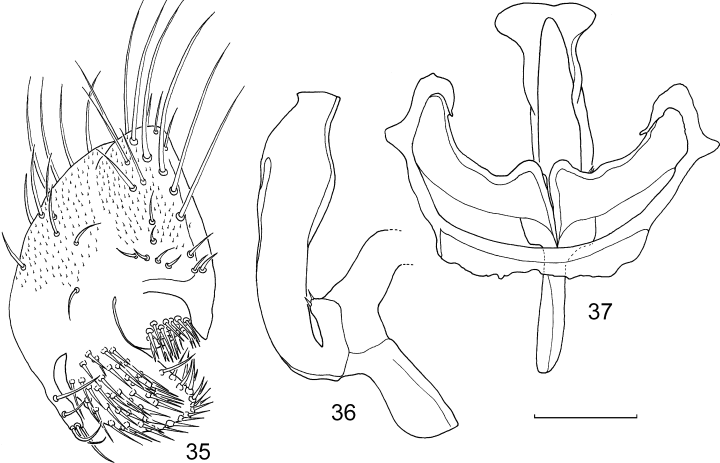
Zygothrica fijiana Takada (male paratype from Levuka, Fiji). 35 Periphallic organs (ventral view); 36,37 phallic organs (36: part, lateral view; 37: ventral view). Scale line: 0.1 mm.
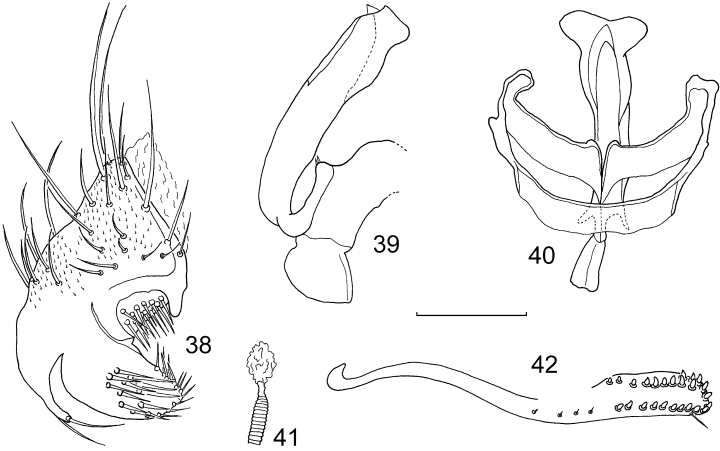
Zygothrica triscutellaris sp. nov. (male holotype and female paratype from Lambir, Sarawak, Malaysia). 38 Periphallic organs (ventral view); 39,40 phallic organs (39: part, lateral view; 40: ventral view); 41 spermatheca; 42 oviscapt (lateral view). Scale line: 0.1 mm.
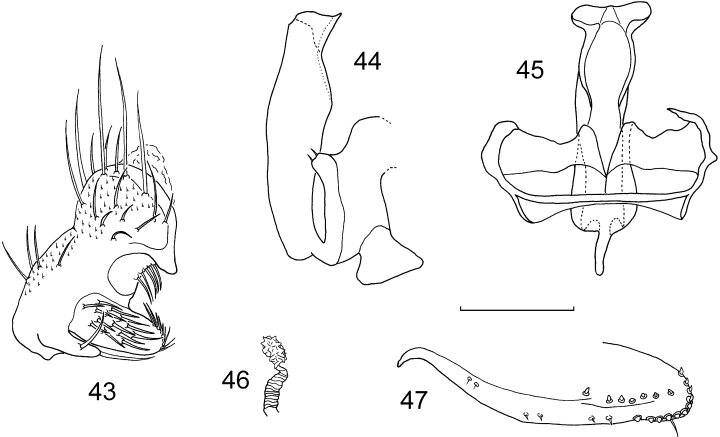
Zygothrica bicornigera sp. nov. (male holotype and female paratype from Los Banos, the Philippines). 43 Periphallic organs (ventral view); 44,45 phallic organs (44: part, lateral view; 45: ventral view); 46 spermatheca; 47 oviscapt (lateral view). Scale line: 0.1 mm.
Common characters. Head: Ocellar triangle small, dark brown; frontal vittae black, anteriorly paler, separated by yellowish median vitta; fronto-orbital plates yellowish, dorsally separated from frontal vittae by conspicuous black line running down to base of anterior reclinate orbital seta; median occipital sclerite dark gray to brown; carina yellowish brown, protuberant, short; antennal scape dark brown; pedicel light to dark brown, with two long setae and a few smaller ones; first flagellomere light grayish yellow; clypeus narrow, dark brown; palpus horizontally flat, with one long (as long as width of palpus) subapical seta and several shorter setae on outer margin; lacinia long, dark brown. Thorax: Scutum and scutellum nearly uniformly black; postpronotal setae approximately four (two dorsals shorter); presutural supra-alar seta shorter than posterior notopleural; prescutellar setae less differentiated; anterior katepisternal seta thin. Abdomen: Tergites I–IV dorsally entirely black, laterally yellow to white. Male terminalia: Epandrium pubescent except for ventral portion and anterolateral margin; cercus pubescent except for ventral portion, fused to caudoventral portion of epandrium; hypandrium much wider than long; paramere fused basally to aedeagus and apically to hypandrium, with two setulae; aedeagus fused to apodeme; aedeagal guide fused to hypandrium apically; apodeme shorter than aedeagus, laterally flat. Female terminalia: Spermathecal capsule small and membranous; duct not introverted.
Distribution. From the Philippines (northernmost) and Borneo (westernmost) to Fiji (south-easternmost). The three included species seem to be allopatric (Fig. 34).
Zygothrica fijiana Takada (Figs 35–37)
Zygothrica fijiana Takada (1976): 68; Grimaldi (1990): 17.
Diagnosis. Epandrial ventral lobe with five to eight setae; surstylus with 29–44 prensisetae distributed over nearly entire outer surface and 21–24 marginal setae (Fig. 35).
Male. Head: Posterior reclinate orbital seta closer to anterior reclinate orbital than to inner vertical. Abdomen: Tergite V dorsally black, with yellow side extension dorsally visible; tergite VI nearly entirely yellow. Terminalia (Figs 35–37): Epandrium with 11–15 setae on submedial to dorsal portion per side. Cercus with 26–30 setae and broad ventral lobe bearing 15–20 setae. Apicolateral fin-like flanges of distiphallus angled, but not acutely pointed at ventral corner.
Measurements: BL (2.64 mm), ThL 1.62 mm (1.59–1.67), WL 2.56 mm (2.44–2.68), WW 1.25 mm (1.18–1.32).
Indices: arb 6/2 (5–6/1–2), FW/HW 0.47 (0.42–0.49), ch/o (0.17), prem/o 0.63 (0.63–0.77), palp/o (0.43), prorb (1.38), rcorb (0.88), dcl (0.57), sctl (0.94), sctl2 (0.44), sterno (0.86), orbito (1.13), dcp (0.23), sctlp (1.08), sctlp2 (0.23), C (1.73), 4c (1.37), 4v (2.14), 5x (0.94), ac (4.36), M (0.46), C3F (0.53).
Female. Head and thorax as in male. Abdominal tergite VI dorsally gray.
Measurements: BL 2.95 mm, ThL 1.51 mm, WL 2.20 mm, WW 1.15 mm.
Indices: arb 5–6/1–2, FW/HW 0.45, ch/o 0.18, prem/o 0.80, palp/o 0.50, prorb 0.94, rcorb 0.61, dcl 0.52, sctl 0.88, sctl2 0.45, sterno 0.85, orbito 1.00, dcp 0.23, sctlp 1.36, sctlp2 0.22, C 1.50, 4c 1.39, 4v 2.08, 5x 1.00, ac 5.00, M 0.42, C3F 0.62.
Specimens examined. Fiji: 1♂ (holotype of Z. fijiana: SEHU), labeled “Levuka, Draiba village, Fiji, 29.vii.1973, H. Takada”; 3♂1♀ (paratypes of Z. fijiana: SEHU), same collection data as holotype.
Distribution. Fiji, Vanuatu.
Remarks. Takada (1976) designated 16 specimens collected together with the holotype as one female allotype and 15 (10 males and five females) paratypes. However, we found only four paratype specimens from the type series, which are now deposed in SEHU.
Zygothrica triscutellaris sp. nov. (1–3, 38–42)
Diagnosis. Surstylus with ten to 11 prensisetae on only submedial outer surface and 13–16 marginal setae (Fig. 38); apicolateral fin-like flanges of distiphallus round on ventral margin (Fig. 39).
Male. Head: Ocelli yellow. Anterior reclinate orbital seta usually equidistant from proclinate and posterior reclinate orbitals; posterior reclinate orbital seta slightly closer to anterior reclinate orbital than to inner vertical. Gena yellow but black from facial ridge to small area below ventral apex of eye and base of vibrissa. Prementum entirely dark brown. Thorax: Basal scutellars slightly convergent; apical scutellars somewhat parallel. Legs white except for apical part of tarsi (distal half of fourth tarsomeres and whole of fifths brown). Abdomen: Tergite V dorsally black, with white side extension dorsally visible; tergite VI entirely white. Terminalia (Figs 38–40): Epandrium with seven to 13 setae on submedial to dorsal portion per side and two to four setae on ventral lobe. Cercus with 23–28 setae and broad ventral lobe bearing 11–16 setae.
Measurements: BL 2.55 mm (2.73–2.95), ThL 1.29 mm (1.26–1.44), WL 2.20 mm (2.06–2.36), WW 1.08 mm (1.02–1.15).
Indices: arb 4–5/1–2 (4–5/1–2), FW/HW 0.38 (0.41–0.44), ch/o 0.15 (0.15–0.16), prem/o 0.74 (0.70–0.76); palp/o 0.44 (0.40–0.41), prorb 1.07 (1.15–1.17), rcorb 0.70 (0.75–0.85), dcl 0.58 (0.53–0.59), sctl 0.83 (0.90–0.91), sctl2 0.53 (0.42–0.50), sterno 0.94 (0.86–1.06), orbito 1.83 (1.58–1.83), dcp 0.22 (0.25), sctlp 1.40 (1.50–1.59), sctlp2 0.24 (0.23–0.27), C 1.51 (1.37–1.43), 4c 1.50 (1.42–1.49), 4v 2.10 (1.90–2.00), 5x 0.93 (0.93–1.07), ac 4.50 (4.73–4.95), M 0.43 (0.39–0.46), C3F 0.53 (0.54–0.67).
Female. Head and thorax as in male. Abdominal tergite VI dorsally faintly gray. Terminalia (Figs 41,42): Oviscapt with approximately nine lateral and 19–20 marginal peg-like ovisensilla. Spermathecal capsule much reduced, membranous, strongly crinkled.
Measurements: BL 2.47–2.58 mm, ThL 1.27–1.38 mm, WL 2.12–2.33 mm, WW 1.00–1.14 mm.
Indices: arb 4–5/1–2, FW/HW 0.40–0.41, ch/o 0.15–0.18, prem/o 0.73–0.77, palp/o 0.40–0.49, prorb 1.00–1.18, rcorb 0.79–0.83, dcl 0.48–0.53, sctl 0.85–0.89, sctl2 0.47–0.50, sterno 0.94–1.07, orbito 1.82–1.92, dcp 0.21–0.24, sctlp 1.50–1.75, sctlp2 0.24–0.32, C 1.33–1.44, 4c 1.44–1.58, 4v 2.03–2.19, 5x 0.97–1.07, ac 5.00–5.44, M 0.47–0.48, C3F 0.54–0.63.
Holotype. Malaysia:♂ (FRCK), labeled “Lambir, Sarawak, Malaysia, 11.i.1999, ex fallen logs, M.J. Toda.”
Paratypes. 2♂3♀ (1♂2♀ in FRCK, 1♂1♀ in SEHU), same collection data as holotype but ex tree trunks.
Etymology. Referring to the three pairs of scutellar setae.
Distribution. Malaysia (Sarawak).
Remarks. This species closely resembles Z. fijiana, but can be distinguished from it by the diagnostic characters and the smaller number of setae on the ventral lobe of the epandrium in males. However, no discriminative difference was observed in females between the two species. The species identity of female specimens were determined on the basis of their collection localities, because these two species are so far known from widely separated ranges: Z. triscutellaris sp. nov. is endemic to Borneo but Z. fijiana is from Melanesia (Fig. 34).
Zygothrica bicornigera sp. nov. (Figs 43–47)
Zygothrica fijiana Grimaldi (1990) (part): 17.
Diagnosis. Cercal ventral lobe broad, somewhat quadrate, with nearly horizontal and flat row of five to ten setae (Fig. 43); apicolateral fin-like flanges of distiphallus acutely pointed at ventral corner (Fig. 44); aedeagus submedially expanded ventrad, slightly constricted subapically in lateral view (Fig. 44).
Male. Same body coloration as Z. triscutellaris. Head: Anterior reclinate orbital seta closer to posterior reclinate than to proclinate orbitals; posterior reclinate orbital seta slightly closer to anterior reclinate orbital than to inner vertical. Thorax: Basal scutellar setae slightly convergent; apical scutellars somewhat parallel. Terminalia (Figs 43–45): Epandrium with seven to 13 setae on submedial to dorsal portion per side and two to four setae on ventral lobe. Surstylus with 11–21 prensisetae distributed over large area of outer surface and eight to 15 marginal setae. Cercus with 18–26 setae.
Measurements: BL 2.92 mm (1.85–3.11), ThL 1.62 mm (0.92–1.55), WL 2.56 mm (1.70–2.52), WW 1.23 mm (0.83–1.23).
Indices: arb 4–5/1–2 (4–5/1–2), FW/HW 0.38 (0.38–0.42), ch/o 0.17 (0.15–0.19), prem/o (0.61–0.72); palp/o 0.40 (0.31–0.43), prorb 1.00 (1.05–1.20), rcorb 0.85 (0.65–0.83), dcl 0.58 (0.44–0.59), sctl 0.87 (0.78–0.90), sctl2 0.44 (0.32–0.48), sterno 1.05 (0.86–1.16), orbito 2.00 (1.43–1.80), dcp 0.20 (0.17–0.27), sctlp 1.73 (1.29–1.63), sctlp2 0.21 (0.19–0.31), C 1.35 (1.12–1.42), 4c 1.41 (1.43–1.83), 4v 1.97 (2.00–2.38), 5x 1.20 (1.09–1.50), ac 5.00 (3.91–5.00), M 0.46 (0.50–0.56), C3F 0.57 (0.51–0.67).
Female. Head and thorax as in male. Terminalia (Figs 46,47): Oviscapt with six to seven lateral and 14–18 marginal peg-like ovisensilla. Spermathecal capsule much reduced, membranous, strongly crinkled.
Measurements: BL 2.03–3.03 mm, ThL 0.86–1.56 mm, WL 1.64–2.52 mm, WW 0.82–1.21 mm.
Indices: arb 3–5/1–2, FW/HW 0.38–0.44, ch/o 0.15–0.19, prem/o 0.62–0.76, palp/o 0.35–0.45, prorb 0.87–1.08, rcorb 0.64–0.77, dcl 0.40–0.61, sctl 0.80–0.88, sctl2 0.40–0.63, sterno 0.89–1.06, orbito 1.57–2.38, dcp 0.19–0.26, sctlp 1.40–1.83, sctlp2 0.25–0.29, C 1.05–1.31, 4c 1.46–1.74, 4v 1.92–2.33, 5x 1.13–1.47, ac 4.10–5.80, M 0.44–0.58, C3F 0.55–0.69.
Holotype. The Philippines:♂ (SEHU), labeled “Dasmarinas, Los Banos, the Philippines, 25–30.x.1990, K. Ichinose.”
Paratypes. The Philippines: 28♂34♀ (3♂3♀ in AM, 3♂3♀ in BMNH, 3♂3♀ in BISH, 3♂3♀ in NMNH, 3♂3♀ in NSMT, 13♂19♀ in SEHU), same collection data as holotype. Indonesia: 1♂1♀ (BISH), Ifar [River], Cyclops Mountains, Irian Jaya, 300–500 m, 28–30.vi.1962, J.L. Gressitt (misidentified as Z. fijiana by Grimaldi 1990).
Etymology. Referring to the pair of acute flanges of distiphallus.
Distribution. The Philippines (Luzon), Indonesia (Irian Jaya).
Remarks. This species resembles Z. triscutellaris, but differs from it in having the acutely pointed apicolateral fin-like flanges of distiphallus, the smaller numbers of setae on the ventral lobe of cercus and the lateral and marginal ovisensilla, and the greater number of prensisetae on the surstylus.
Zygothrica leptorostra species subgroup
Diagnosis. Palpus very broad, flat, with a few short apical setae (Fig. 3); proboscis very long, extremely narrow, yellow (Fig. 3); labellum very small, as narrow as apex of prementum (Fig. 3); frontal vittae light brown to yellow (Fig. 3); fronto-orbital plates light yellow, graded to black behind anterior reclinate orbital setae; epandrial ventral lobe very large, with pubescence and many long setae (49–53, 54–58); surstylus long, somewhat crescentic, with large prensisetae in concave row on distal medial margin and very thin setae scattered on apical part (49–53, 54–58); hypoproctal plate long, narrow, with a few tiny setulae (49–53, 54–58); cercus without ventral lobe (49–53, 54–58); distiphallus apically with a pair of flaps slightly serrated on margin (49–53, 54–58); spermathecal capsule elongate, sclerotized, smooth on surface, with basal collar and introvert extended approximately four-fifths of the length of capsule (49–53, 54–58).
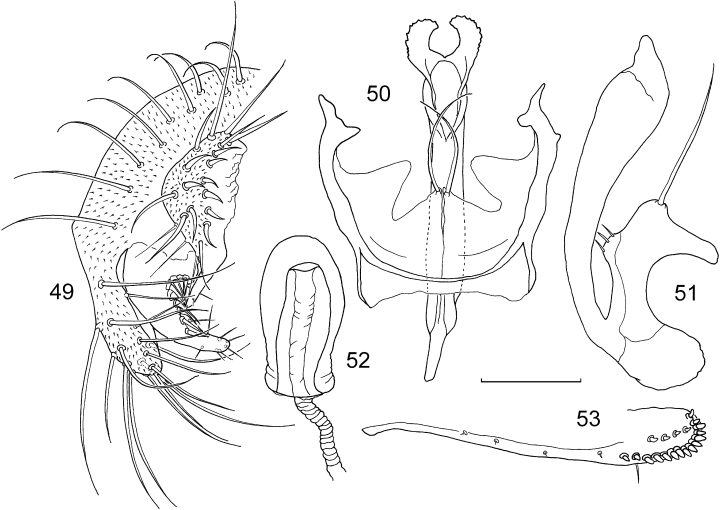
Zygothrica quintamaculata sp. nov. (male holotype and female paratype from Mount Kinabalu, Sabah, Malaysia). 49 Periphallic organs (caudal view); 50,51 phallic organs (50: ventral view; 51: part, lateral view); 52 spermatheca; 53 oviscapt (lateral view). Scale line: 0.1 mm.
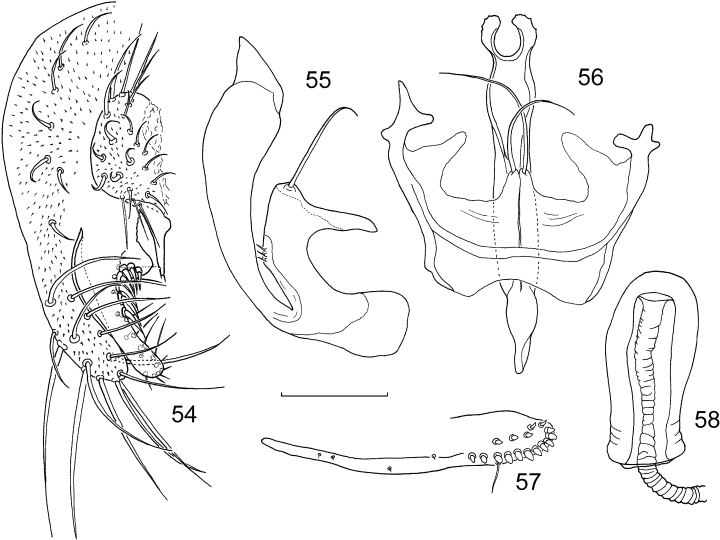
Zygothrica pimacula sp. nov. (male paratype from Taiwan, China; female paratype from Hainan Island, China). 54 Periphallic organs (caudal view); 55,56 phallic organs (55: part, lateral view; 56: ventral view); 57 oviscapt (lateral view); 58 spermatheca. Scale line: 0.1 mm.
Common characters. Head: Ocellar triangle black, anteriorly tapered, leading to very narrow vitta between frontal vittae; ocelli light yellow; anterior reclinate orbital seta closer to proclinate than to posterior reclinate orbital; posterior reclinate orbital seta closer to anterior reclinate orbital than to inner vertical; gena yellow but black from facial ridge to black spot below eye; face moderately splayed anterolaterally, medially yellow, dark brown on upper sides of carina; carina protuberant; antenna light brown to yellow; pedicel with only one long and a few smaller setae; clypeus narrow, dark brown; lacinia thin, yellow, shorter than palpus. Thorax: Scutum and scutellum dark brown but black along dorsocentral lines and lateral margins of scutellum; postpronotal setae two; prescutellar setae not differentiated; two pairs of scutellar setae: basals convergent and apicals cruciate; legs entirely yellowish white. Male terminalia: Epandrium pubescent except for anterolateral margin; cercus pubescent except for hypoproctal plate, separated from epandrium; hypandrium somewhat quadrate, with a pair of triangular lobes on inner lateral margins and apposed median lobes each bearing long curved paramedian seta apically; paramere fused basally to aedeagus and apically to hypandrium, with approximately three setulae; aedeagal apodeme shorter than aedeagus, laterally flat.
Distribution. From Malay Peninsula (westernmost) and southern China (northernmost) to Papua New Guinea (south-easternmost) (Fig. 48).
Zygothrica leptorostra Grimaldi
Zygothrica leptorostra Grimaldi (1990): 4.
Diagnosis. Palpus shorter than maximum diameter of eye; abdominal tergite IV dark brown and V completely yellow in both sexes (not dark brown as described by Grimaldi 1990); epandrial ventral lobe with nine to ten setae on posterior to apical margin (referred to as medial-marginal row in Grimaldi 1990).
Specimens examined. Papua New Guinea: 1♂ (holotype of Z. leptorostra: BMNH & BM 1933–427), labeled “Kokoda, Papua New Guinea, 1200 ft., iv.1933, L.E. Cheesman, on fungus”; 2♂6♀ (paratypes of Z. leptorostra: BMNH), same collection data as holotype; 6♀ (paratypes of Z. leptorostra: BMNH), same collection data as holotype except for vii.1933, determined by D. Grimaldi in 1989. Malaysia: 1♀ (BISH), Gua ‘Che Yatim, King George V National Park, Pahang, 16.xii.1958, L.W. Quate, determined by D. Grimaldi.
Distribution. Papua New Guinea, Malaysia.
Remarks. Grimaldi (1990) described and illustrated the presence of an anterior ventral lobe of the epandrium, in addition to the posterior lobe. However, the “anterior lobe” illustrated by him (Grimaldi 1990; fig. 2) is probably the apodeme broken from the epandrium, and therefore the “posterior lobe” is the ventral lobe proper.
Zygothrica quintamaculata sp. nov. (1–3, 49–53)
Diagnosis. Palpus as long as maximum diameter of eye (Fig. 3); abdominal tergite IV black except for lateral yellow patches and V with medially interrupted black patches; eight or nine prensisetae lying on more than half of surstylus distal margin (Fig. 49).
Male. Head (Fig. 3): Eye light red. Thorax: Scutum with a pair of paramedian (running just inside dorsocentral lines), light brown, short vittae only on anterior part (far before transverse suture) of scutum. Presutural supra-alar seta as long as anterior notopleural. Acrostichal setulae in eight irregular rows. Anterior katepisternal seta as thick as posterior. Abdomen: Tergites I–IV dorsally entirely black, laterally white; VI entirely white. Terminalia (Figs 49–51): Epandrium with eight to 10 setae on submedial to dorsal portion per side and four or five setae on lateral surface (referred to as lateral row in Grimaldi 1990), four to six on posterior to apical margin and five or six on anterior to apical margin (referred to as lateral-marginal row in Grimaldi 1990) of ventral lobe. Cercus with 16–21 setae.
Measurements: BL 2.49 mm (2.18–2.63), ThL 1.25 mm (1.08–1.29), WL 2.55 mm (2.26–2.61), WW 1.10 mm (1.04–1.18).
Indices: arb 4/1 (3–4/1), FW/HW 0.42 (0.39–0.45), ch/o 0.22 (0.19–0.26), prem/o 1.32 (1.13–1.31), palp/o 1.04 (0.88–1.04), prorb 1.11 (0.90–1.11), rcorb 0.56 (0.44–0.64), dcl 0.50 (0.40–0.61), sctl 0.77 (0.73–0.91), sterno 0.93 (0.75–0.96), orbito 1.20 (1.00–1.50), dcp 0.28 (0.24–0.29), sctlp 1.25 (1.08–1.57), C 1.57 (1.65–1.94), 4c 1.52 (1.36–1.56), 4v 2.21 (2.04–2.44), 5x 2.00 (1.50–2.00), ac 4.40 (3.15–4.00), M 0.66 (0.57–0.73), C3F 0.59 (0.54–0.64).
Female. Head, thorax and abdomen as in male. Terminalia (Figs 52,53): Oviscapt with three or four lateral and 10–15 peg-like and approximately four minute marginal ovisensilla.
Measurements: BL 2.65–3.22 mm, ThL 1.22–1.47 mm, WL 2.69–3.04 mm, WW 1.12–1.33 mm.
Indices: arb 3–4/1, FW/HW 0.41–0.47, ch/o 0.20–0.25, prem/o 1.24–1.39, palp/o 0.97–1.12, prorb 0.91–1.11, rcorb 0.45–0.67, dcl 0.45–0.70, sctl 0.78–0.95, sterno 0.75–1.00, orbito 1.00–1.60, dcp 0.16–0.28, sctlp 0.90–2.00, C 1.53–2.07, 4c 1.32–1.52, 4v 2.04–2.38, 5x 1.48–1.82, ac 3.14–3.85, M 0.59–0.67, C3F 0.53–0.63.
Holotype. Malaysia:♂ (KPSP), labeled “Park Headquarters, Mt. Kinabalu, Sabah, Malaysia, 2.i.1999, ex fungi of Pleurotus?, M.J. Toda.”
Paratypes. Malaysia: 166♂207♀ (10♂10♀ in AM, 10♂10♀ in BMNH, 10♂10♀ in BISH, 10♂10♀ in ITBC, 10♂10♀ in NMNH, 10♂10♀ in NSMT, 106♂147♀ in SEHU), same collection data as holotype; 1♂1♀ (KPSP), same collection data as holotype but ex tree trunks; 19♂25♀ (KPSP), same collection data as holotype but 24.vi.2000, ex fungi; 1♂ (ITBC), Mahua, Crocker Range National Park, Sabah, 23.x.1999, K. Mizota.
Etymology. Referring to the abdominal tergite V with black patches.
Distribution. Malaysia (Sabah).
Remarks. This species is clearly distinguishable from the other species of the leptorostra subgroup by the larger palpus and the color pattern of abdominal tergites IV and V.
Zygothrica pimacula sp. nov. (Figs 54–58)
Diagnosis. Palpus shorter than maximum diameter of eye; scutum with median (running through entire length) and a pair of paramedian (running from anterior margin behind transverse suture) light brown vittae; dorsal black patch on abdominal tergite II medially interrupted in male but sometimes in female; tergite IV with pi (π)-shaped black marking in male but widely black except for small lateral white patches in female; tergite V completely white in both sexes; epandrial ventral lobe with five or six setae on posterior to apical margin (Fig. 54); approximately seven prensisetae lying on upper half of surstylus distal margin (Fig. 54).
Male. Head: Median occipital sclerite yellowish orange. Thorax: Presutural supra-alar seta as long as posterior notopleural. Acrostichal setulae in six or eight irregular rows. Anterior katepisternal seta thinner than posterior. Abdomen: Tergites I and III dorsally entirely black, laterally white; VI entirely white. Terminalia (Figs 54–56): Epandrium with seven to ten setae on submedial to dorsal portion per side and four to six setae on lateral surface and three to six on anterior to apical margin of ventral lobe. Cercus with 16–21 setae.
Measurements: BL 2.27 mm (2.33), ThL 1.12 mm (1.10), WL 2.27 mm (2.20), WW 1.04 mm (1.04).
Indices: arb 3/1 (4/1), FW/HW 0.56 (0.58), ch/o 0.18 (0.16), prem/o 1.27 (1.14), palp/o 0.82 (0.73), prorb 1.00 (1.00), rcorb 0.56 (0.55), dcl 0.63 (0.53), sctl 0.74 (0.79), sterno 0.88 (1.08), orbito 1.33 (1.00), dcp 0.32 (0.30), sctlp 1.43 (1.33), C 1.62 (1.56), 4c 1.63 (1.64), 4v 2.38 (2.30), 5x 1.89 (1.89), ac 3.90 (3.85), M 0.75 (0.72), C3F 0.56 (0.56).
Female. Head and thorax as in male. Terminalia (Figs 57,58): Oviscapt with two to four lateral and 11–13 peg-like and approximately four minute marginal ovisensilla.
Measurements: BL 2.53–2.75 mm, ThL 1.14–1.29 mm, WL 2.00–2.64 mm, WW 0.94–1.12 mm.
Indices: arb 3–4/1, FW/HW 0.42–0.45, ch/o 0.17–0.21, prem/o 1.21–1.28, palp/o 0.75–0.88, prorb 0.99–1.11, rcorb 0.50–0.65, dcl 0.36–0.58, sctl 0.70–0.80, sterno 0.80–0.93, orbito 1.00–1.33, dcp 0.23–0.33, sctlp 1.11–1.46, C 1.51–1.85, 4c 1.38–1.67, 4v 2.23–2.50, 5x 1.80–2.11, ac 3.60–4.21, M 0.64–0.76, C3F 0.57–0.62.
Holotype. China:♂ (SEHU), labeled “Chitou, Taiwan, 14.x.1992, ex fungi (Aphyllophorales), M.J. Toda.”
Paratypes. China: 1♂1♀ (SEHU), same collection data as holotype; 3♀ (1♀ in SEHU, 2♀ in GIE), Jianfengling, Ledong County, Hainan Island, 800 m, 24.ix.1993, M.J. Toda. The Philippines: 1♀ (SEHU), National Botanical Garden, Real Quezon, 3–4.xi.1990, K. Ichinose. Vietnam: 1♀ (CPNP), Cuc Phuong, 4.iv.2000, ex white fungi, M. Yafuso.
Etymology. Referring to the pi (π)-shaped black marking on male abdominal tergite IV.
Distribution. China (Taiwan, Hainan Island), the Philippines, Vietnam.
Remarks. This species resembles Z. leptorostra in having the palpus shorter than the maximum diameter of the eye, but can be distinguished from it by the color pattern of abdominal tergite IV (in leptorostra it is dorsally entirely black) and the smaller number of setae on the posterior to apical margin of epandrial ventral lobe (in leptorostra there are nine or ten setae) in males. However, only slight differences between these two species are seen in the coloration of the scutum and anterior abdominal tergites in some females.
Key to species of the Zygothrica samoaensis group
- 1
Proboscis yellow; palpus very broad, flat, longer than three-fourths maximum diameter of eye .....................Z. leptorostra subgroup, 2
- –
Proboscis blackish; palpus moderate in size, shorter than half maximum diameter of eye ............4
- 2
Abdominal tergite V with black markings; palpus as long as maximum diameter of eye ............................Z. quintamaculata sp. nov.
- –
Tergite V entirely white or yellow; palpus shorter than maximum diameter of eye ...............3
- 3
Abdominal tergite IV dorsally black in male and female; epandrial ventral lobe with nine or ten setae on posterior to apical margin ..........................Z. leptorostra Grimaldi
- –
Tergite IV with pi (π)-shaped black marking in male, dorsally entirely black in female, epandrial ventral lobe with five or six setae on posterior to apical margin ..................................................Z. pimacula sp. nov.
- 4
Scutellar setae three pairs; epandrium with ventral lobe .............................Z. fijiana subgroup, 5
- –
Scutellar setae two pairs; epandrium without ventral lobe .......................Z. samoaensis subgroup, 7
- 5
Epandrial ventral lobe with five to eight setae; surstylus with 29–44 prensisetae distributed over nearly entire outer surface ..................Z. fijiana Takada
- –
Epandrial ventral lobe with two to four setae; surstylus with less than 22 prensisetae on outer surface ..............................................6
- 6
Surstylus with ten to 11 prensisetae on only submedial outer surface; apicolateral fin-like flanges of distiphallus round on ventral margin .........................................Z. triscutellaris sp. nov.
- –
Surstylus with 11–21 prensisetae distributed over large area of outer surface; apicolateral fin-like flanges of distiphallus acutely pointed at ventral corner................................... Z. bicornigera sp. nov.
- 7
Wing apically with dark marking(s) at least in male .........................................8
- –
Wing apically without dark marking(s) ..........9
- 8
Wing apically with large black spot only in male ............................Z. aliunota Grimaldi
- –
Wing with small brown spots at apices of R2+3, R4+5 and M1...............................Z. carsoni Grimaldi
- 9
Face with dark brown band running over ventral half of carina ..............Z. prosopeiona Grimaldi
- –
Face without conspicuous band on carina ........10
- 10
Prementum not completely dark brown; distiphallus adorned with a pair of retrorse hooks .....................11
- –
Prementum completely dark brown to black; distiphallus without retrorse hooks .......................12
- 11
Prementum mostly dark brown, but ochre to white at proximal end; surstylus approximately twice as long as wide, wrinkled on proximal outer surface; distiphallal retrorse hook with concave dorsosubapical margin in lateral view .......................................Z. malaysiana Grimaldi
- –
Prementum mostly yellowish brown, but dark brown only at distal end; surstylus approximately 1.5 times as long as wide, not wrinkled on proximal outer surface; distiphallal retrorse hook with nearly straight dorsosubapical margin in lateral view .................................Z. orientalis Grimaldi
- 12
Cercus with strong setation near ventral margin ........................................Z. australiaensis sp. nov.
- –
Cercus without strong setation near ventral margin ......................................13
- 13
Aedeagus with swollen apical labia .........................Z. waui Grimaldi
- –
Aedeagus without apical labia .................14
- 14
Cercal ventral lobe with six to 10 stout setae .................Z. flavofinira Takada
- –
Cercal ventral lobe with two or three thin setae .....................Z. samoaensis Malloch
Females of some species are difficult, if not impossible (see diagnosis and description for each species), to identify to species morphologically.
Nomenclatural changes
Grimaldi (1990) described two species, Z. kokodana and Z. paleovitta, each representing an independent species group, the kokodana and the paleovitta groups, respectively, from the Indo-Pacific region. We examined the holotypes of these species, and concluded that they should be moved to the genus Hirtodrosophila because they certainly belong to the H. hirticornis species group and the H. quadrivittata species group, respectively.
Hirtodrosophila kokodana (Grimaldi), comb. nov.
Zygothrica kokodana Grimaldi (1990): 22.
This species belongs to the latifrontata subgroup of the H. hirticornis species group because it has the following diagnostic characters (see Burla 1956; Okada 1967; Bächli 1973): Posterior reclinate orbital seta closer to proclinate orbital seta than to inner vertical seta; first flagellomere with dense covering of long sensilla, especially anteriorly; frons much wider than long; anterior reclinate orbital seta situated directly lateral to proclinate orbital seta; C < 1.3; 4c > 1.5; 4v > 2.0; epandrial anteroventral corner much elongated below; surstylus narrower than long, strongly concaved on distal margin.
Specimen examined. Papua New Guinea: 1♂ (holotype of Z. kokodana: BMNH, BM1933-427), labeled “Kokoda, Papua New Guinea, 1200 ft, iv.1933, L.E. Cheesman.”
Hirtodrosophila paleovitta (Grimaldi), comb. nov.
Zygothrica paleovitta Grimaldi (1990): 23.
This species belongs to the trivittata subgroup of the H. quadrivittata species group because it has the following diagnostic characters (see Okada 1956; Chung 1960): Scutum with three distinct broad longitudinal black stripes confluent posteriorly; frons with median black stripe; cercus elongated below, apically bearing stout setae; epandrial ventral lobe pendulous, bearing long setae; surstylus crescent, pendulous, with a row of prensisetae on concave distal margin.
Specimens examined. Malaysia: 1♂ (holotype of Z. paleovitta: BISH), labeled “Gua ‘Che Yatim, King George V National Park, Pahang, Malaysia, 16.xii.1958, L.W. Quate”; 1♀ (paratype of Z. paleovitta: BISH), same collection data as holotype; 1♀ (paratype of Z. paleovitta: BISH), same collection data but J.L. Gressitt collector.
ACKNOWLEDGMENTS
We thank S. McEvey (AM), who helped us with the loan of some Australian specimens and kindly checked many others deposited in AM; H. Watabe, K. Mizota, K. Ichinose and M. Yafuso for their contribution in collecting flies; and N. Evenhuis and K. Arakaki (BISH), J. Jackson, M. Fitton and N. Wyatt (BMNH), N. Adams, W. Mathis and H. Williams (NMNH), and M. Owada and A. Shinohara (NSMT) for the loans of some type specimens used in this study. Special thanks are due to H.-W. Chen, Y.-G. Hu and M. Tomaru for their kind assistance. This work was funded by a Lavoisier Grant from the French Ministry of Foreign Affairs to S.R.P. (No. 0540) and Grants-in-Aid for Scientific Research from the Japan Society for the Promotion of Science (Nos. 12375002 and 15255006) and Project 2-2 of the Research Institute for Humanity and Nature to M.J.T.




